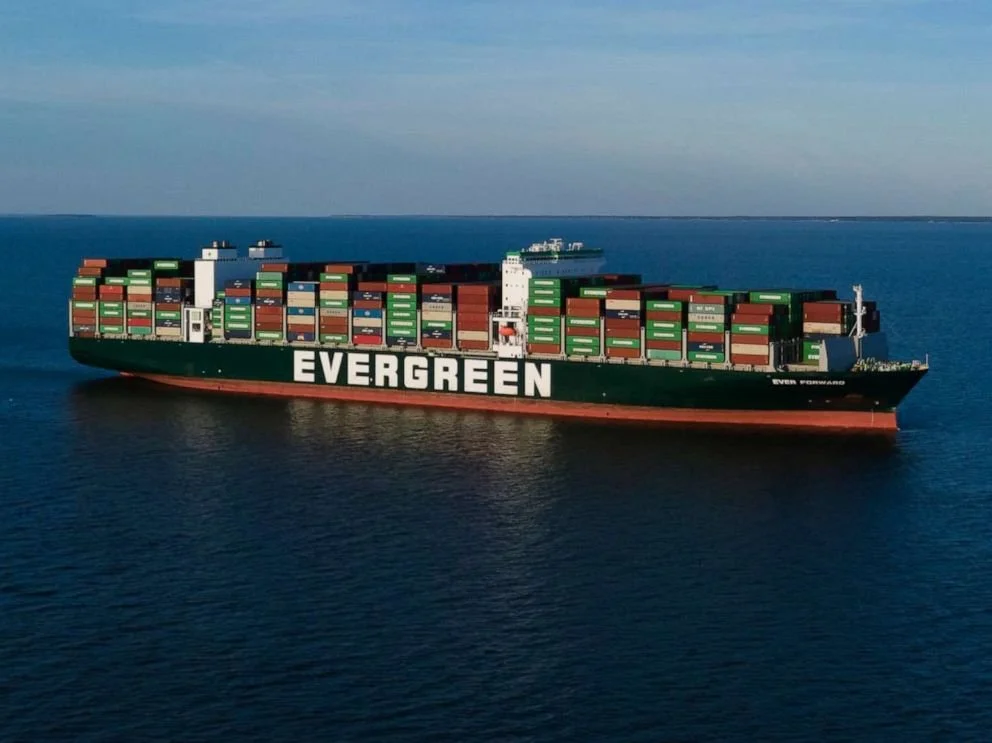ELECTRIC SEAS
Global freight shipping accounts for a similar amount of Co2 emissions as the entire emissions from Germany in a year 2.5% of the total. International shipping has been steadily growing and shipping emissions could increase by 50% or even 250% without action according to an IMO Greenhouse Gases (GHG) study.
Suez Canal
Giant container ships now roam the oceans, like the goliath MV Evergreen that blocked the Suez Canal in early 2021. Freight cargo is the backbone of our modern economy, carrying 90% of world trade, and globalization means goods are shipping across the world 24/7.
Tackling the emissions from shipping is therefore an essential component of the green revolution. Even tracking the total emissions by country from shipping is fraught with difficulty, as ships are often registered in tax havens and offshore shell companies. When ships are in international waters their carbon emissions are technically regarded as international rather than originating from any one single country. This makes it difficult for regulators to control and limit pollution standards. Global shipping is not covered by the Paris Agreement because it cannot accurately be assigned to countries. If global shipping was a country, it would be the sixth biggest CO2 emitter in the world. The answer is to tackle the ships regardless of which country is responsible. The UN's International Maritime Organization has set a carbon reduction of at least 50% by 2050.
Shipping Container
Given their enormous size, is it feasible to replace giant diesel engines with batteries and electric propellers and are there alternatives? What propelled ships across the globe for centuries is making a modest come back under a modern guise. High-tech wind sails could be helping to propel giant cargo ships across the oceans. Companies like Wallenius Marine are developing the Oceanbird which is a partly sail-driven ship capable of carrying 7,000 cars. Even Airbus plans to equip one of its cargo ships with ‘Airseas’, giant sails helping to pull a ship forward. Sail-assisted freight transport was experimented on during the 1970s and 80s, following the oil crisis. While sails can help, converting ships into fully electric and ultimately autonomous is underway. Already hybrid ships with a combined diesel motor and electric batteries are in use. In Scandinavia, electric ships, which are completely battery powered are already ferrying passengers, with a 100% electric ferry now crossing between Helsingborg in Sweden and Helsingør in Denmark over 40 times a day. With short crossings, the ship charges for just 10 minutes at each end using ultra high-power chargers. The converted ferries are delivering at least a 25% efficiency gain over their former diesel incarnation with 4.1-megawatt hours of battery storage.
Just like electric cars, less maintenance is required with electric ships. Going further, cargo tankers and cruise ships are also being electrified. In China, the Yangtze River Three Gorges 1 is the largest electric cruise ship in the world with a 7.5 MW hour battery capacity. While nowhere on the scale of modern super cruise diesel ships, that can carry thousands of passengers, the Chinese effort is a start and will have the capacity for hundreds of passengers.
Kongsberg & Yara are jointly developing the world's first zero-emissions fully autonomous container ship in Norway. The Birkeland will start life as a manned vessel and then transition to be fully autonomous with an 8 MW hour battery capable of 24/7 operation. In Tokyo the ‘E5’ will be a battery-powered tanker and almost 60 meters long while in China ironically an electrified bulk carrier will be transporting polluting coal, for the time being.
In Japan projects like the ‘Wind Hunter’ will be powered mostly by massive sails while beneath the hull turbines will generate electricity that are then used to run an electrolysis process to create hydrogen onboard which can then be used to power a fuel cell generator. These are just a sample of some of the many exciting electric developments in global shipping. However, the transition to a fully green electric world fleet is only in its infancy.
Even with all the benefits of reduced fuel costs, zero emissions and lower maintenance costs, batteries are still too expensive to completely replace diesel-driven giant ships. As battery costs continue to fall and energy density improves, combined with innovative new shipping technology like sails and solar cells across the ship's large surface area, there will be a gradual rather than exponential shift to electric shipping.
The era of the hybrid ship will likely last for several decades before the likes of solid-state batteries are sufficiently cheap enough to build pure electric ships. Given some of the long distances that shipping takes, it will be a while, similar to long-haul commercial aircraft, before these ocean traversing carriers are replaced with electric. On top of this the question of recharging at the world ports, with tight turnaround times, and the huge power loads required is still a way off.




